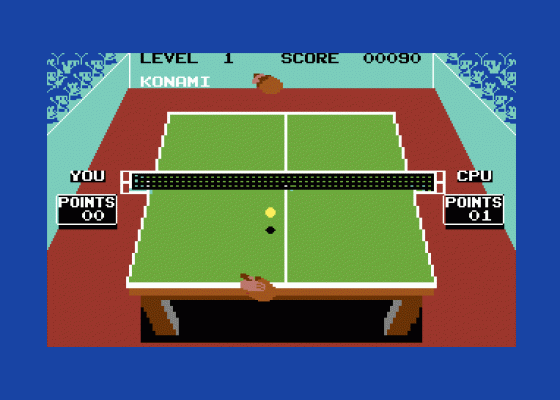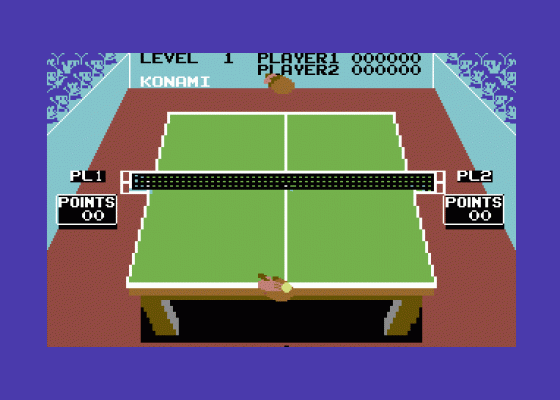Ping Pong
Do you remember when a revolutionary new form of entertainment - a machine called Pong - first appeared in amusement arcades everywhere and everyone said: 'Golly, how thrilling - a revolutionary new form of entertainment!'? Do you remember when Binatone turned it into a 'home arcade console' and everyone said: 'Golly, how thrilling - an arcade game in our very own place of residence!'? No? Well, since then there's not been much heard of Pong. Until now that is, for Imagine have taken the theme, turned it from a horizontal game to a near vertical one and added an extra dimension with 3D graphics.
Ping Pong is played according to the rules of table tennis, the winner being the first to score eleven points. Only one player can play against one of five different computer opponents - there is no two-player option. Level one is a bit docile and bats the ball slowly around the table, but level five is a crazed pongicidal maniac who shows no mercy.
The game is always viewed and played from the base line with your bat positioned about a quarter of the way up the screen (get your eyes and position them above one of the screen shot of you're confused). The score and other relevant information, whether the ball is in or out, for example, is displayed either side of the table. Crowds flank each side of the screen and play a small part in the game - the ones on the right cheer the computer and the ones on the left cheer you.

Your bat automatically follows the ball so it's up to you to time the return. Pressing the fire button drives the ball back, whilst pushing down on the joystick 'cuts' it and pushing up executes a smash. Moving the joystick left or right moves the bat either to the forehand or backhand position and depending upon how early or late you hit the ball it veers either right or left.
Serves are performed by pushing up on the joystick to throw the ball in the air and then pressing the fire button to drive it. After every five points the serving changes hands. If the scoring is tied at ten points a piece then the tie-break comes into effect. In this situation the first player to either go ahead by two points or reach fifteen points (whichever comes first) is declared the outright winner.
Ten points are awarded for a shot and when an opponent is beaten a bonus is awarded. If your score is high enough at the end of a game your initials can be entered in the highscore table.
GP

Ping Pong is initially quite good fun, but it soon proves boring to play due to its simplistic nature. Although there is a reasonable variety of shots available, the computer player doesn't seem to respond that differently to them. The graphics and sound are OK, but it would have been nice to have had some original Martin Galway music on the title screen. Ping Pong is an improvement over the original Pong and more enjoyable to play, but not much.
GL
Yet another case of a potentially good game ruined by the restrictions imposed by the licensing deal. This is a conversion of the arcade game Ping Pong and a very close conversion it is too. Unfortunately, arcade Ping Pong isn't very good in the first place. In a word, or a couple of words, it's dull. The graphics and sound are on a par with the game, ie, dull. I couldn't honestly recommend buying Ping Pong, but it may be worth a look at if table tennis is what you enjoy most.
JR
After playing Ping Pong on the Amstrad and Spectrum I expected great things of the 64 version, but unfortunately it isn't anything special. There is a lack of variety in shots and it seemed to make little difference whether a shot was played early or late. This makes the game rather dull to play. The graphics are OK, but I would have expected a jolly title screen tune or something, as the Spectrum version had an amazing little ditty. If you're a table tennis nut then I suppose this is a good buy, but there are better games than this.
Verdict
Presentation 83%
Five levels of play, a high score table and a few cute touches.
Graphics 61%
Lacking, but adequate.
Sound 58%
A couple of reasonable jingles and noises, but little else.
Hookability 78%
Very simple to get into and play...
Lastability 65%
... but perhaps a little too simple.
Value For Money 65%
Below average price, but then so it should be.
Overall 66%
The best table tennis game on the Commodore, but then it's the only one.
Other Reviews Of Ping Pong For The Commodore 64
Ping Pong (Imagine)
A review
Ping Pong (Ocean)
A review by Mike Pattenden (Commodore User)


 1st June 1986
1st June 1986

